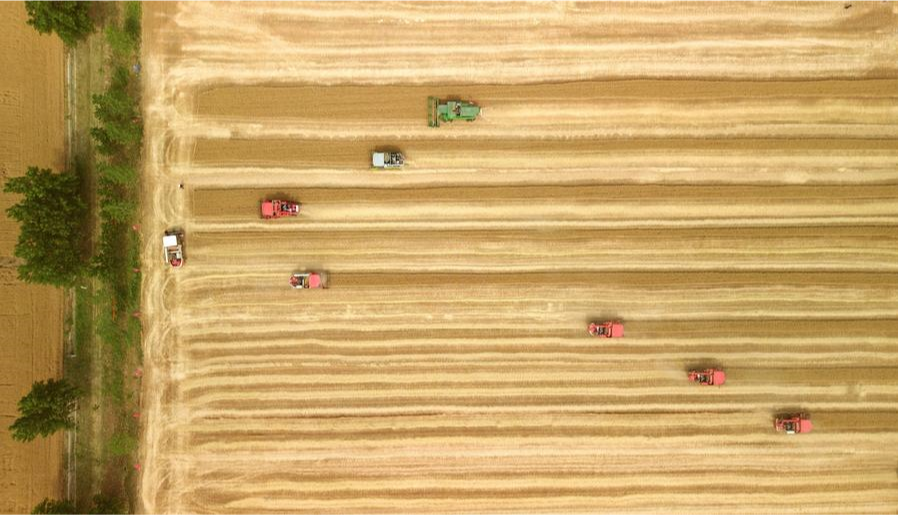
 0 Comment(s)
0 Comment(s) Print
Print E-mail Xinhua, June 20, 2024
E-mail Xinhua, June 20, 2024
An aerial drone photo taken on June 2, 2024 shows reapers harvesting wheat in a field in Tancheng County, east China's Shandong Province. [Photo/Xinhua]
Over a dozen operators drove harvesters in an orderly manner through a vast wheat field in east China's major breadbasket province Shandong. In just 10 minutes, large areas of golden wheat are reduced to short stubble.
"The granaries are already full, yet there's so much grain that the trucks haven't finished unloading," said Guo Bobo, manager of the field and a major grain producer in Wenshang County. Guo's field reaps a record average yield of 9,750 kg per hectare.
Now is the busiest and most rewarding time for farmers like Guo, as China is in its peak summer harvest season, which usually spans from May to late June.
Bumper harvest
Statistics from the Ministry of Agriculture and Rural Affairs indicated that as of June 15, China had harvested around 310 million mu (around 20.68 million hectares) of winter wheat, with harvest progress surpassing 90 percent.
The wheat harvest in southwest China's Sichuan Province and central China's Hubei Province, two agricultural powerhouses, has concluded. Shandong, the country's second-largest wheat producer, has harvested 98.2 percent of its 60.54 million mu of wheat as of Sunday.
Shandong's total grain production has remained stable at over 55 billion kg for three consecutive years. This year, wheat yields and total production are expected to reach new heights, said Yang Wujie, an official from the provincial department of agriculture and rural affairs.
This summer, the main winter-wheat-producing provinces across the country have maintained stable or slightly increased planting areas, with overall wheat growth conditions better than usual, laying a solid foundation for a good summer harvest, according to the ministry.
Behind this progress lies China's commitment to summer grain production by enhancing rural infrastructure, developing high-standard farmlands, and investing in the grain seed industry alongside scientific and technological research.
In Shandong, nearly 76.43 million mu of high-standard farmland have been developed, covering about 80 percent of the province's total cultivated land and 90 percent of permanent basic cropland, according to Yang.
"The strategy of 'storing grain in the field and technology' is fundamental to China's efforts to secure food production capacity," said Li Genying, a researcher at the Crop Research Institute, Shandong Academy of Agricultural Sciences.
China now has around 299 million mu of saline-alkali arable land. Significant progress has been made in salt-tolerant wheat technology, with over 700 new lines and 52 approved varieties undergoing testing for salt-alkali tolerance, said Liu Luxiang, a researcher at the Institute of Crop Sciences, Chinese Academy of Agricultural Sciences (CAAS).
Some of these new varieties have demonstrated promising potential for achieving higher and stable yields, which could significantly enhance grain production capacity, Liu said.
World food stabilizer
According to a report released by the United Nations Food and Agriculture Organization (FAO) on June 7, the FAO Food Price Index continued its upward trend in May for the third consecutive month.
This increase, driven by rising global export prices of wheat, reflects concerns over potentially lower yields due to poor crop conditions in some major producing regions including North America and Europe.
The FAO Cereal Price Index rose by 6.3 percent in May compared to the previous month, contributing significantly to the overall rise in the international food price index.
Food supply in China, the world's largest food producer and third largest food exporter, is significant to global food security and prices.
Statistics from the National Food and Strategic Reserves Administration showed that in 2023, wheat served predominantly as a staple food in China, maintaining a stable and balanced supply-demand relationship throughout the year.
China's grain output rose 1.3 percent year on year to a record high of 695.41 million tonnes last year, which was the ninth consecutive year that the country reported a grain harvest of over 650 million tonnes.
"As a country that accounts for nearly one-fifth of the world's population, China sticks to feeding its people while helping the countries in need with domestically produced food," said Yuan Liang, a researcher at CAAS.
"By avoiding the possibility of exacerbating international food price fluctuations caused by the large purchase of wheat in the international market, China makes great contributions to the stability of the world's food supply," Yuan noted.